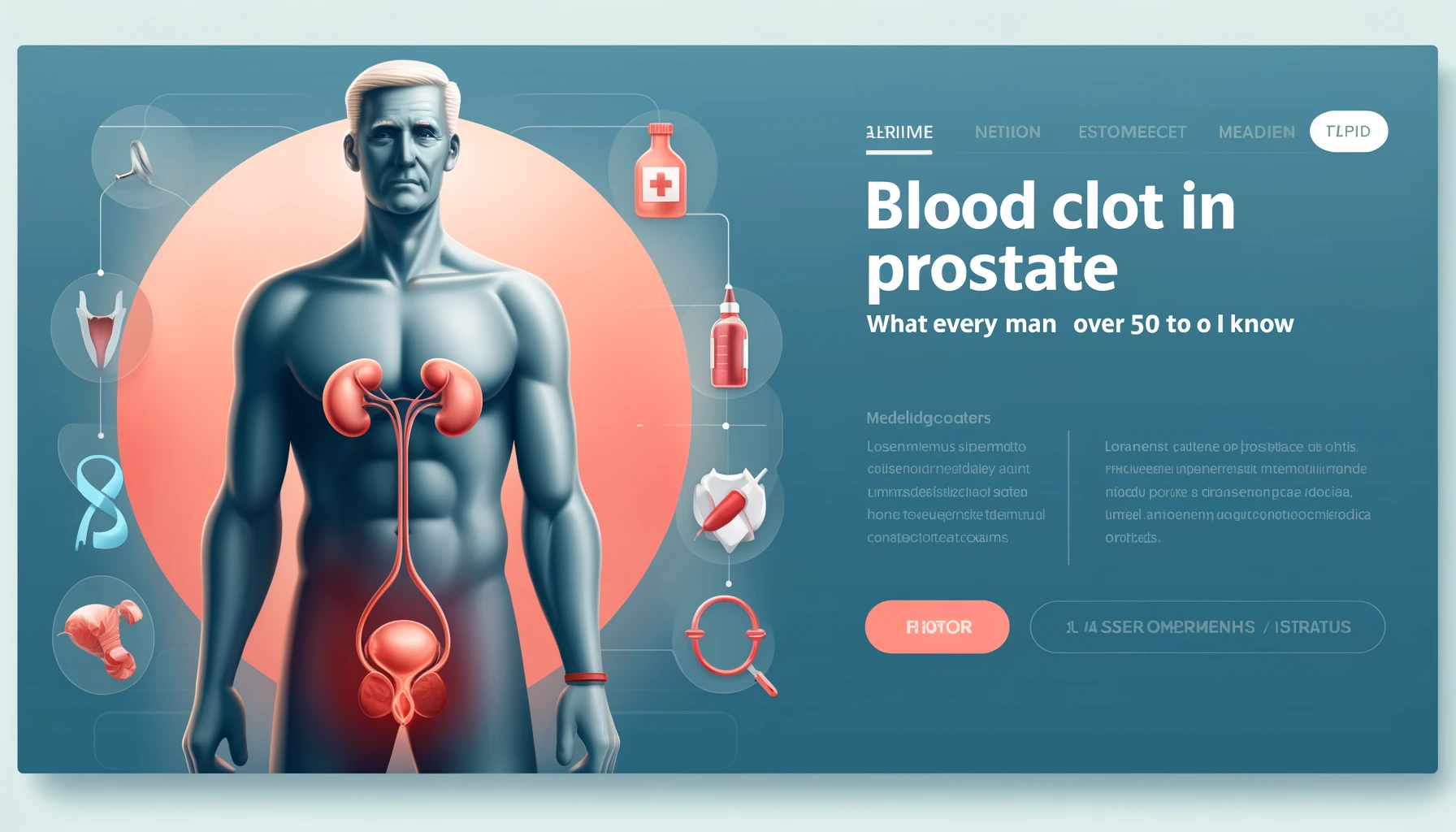Prostate cancer is a prevalent health concern affecting millions of men across the globe. As the second most common cancerous tumor worldwide and the fifth leading cause of cancer-related mortality among men[1], raising awareness about this disease and educating individuals about its causes, risk factors, symptoms, and treatment options is crucial.
Early detection and intervention can significantly improve outcomes and quality of life for prostate cancer patients. This article aims to provide a comprehensive overview of prostate cancer, equipping readers with the knowledge they need to make informed decisions about their health and the health of their loved ones.
Contents
What is Prostate Cancer?
Prostate cancer is a type of malignant growth in the prostate gland, an essential component of the male reproductive system[5]. The prostate gland is a walnut-sized organ located below the bladder and in front of the rectum. It surrounds the urethra, the tube responsible for carrying urine and semen out of the body. The prostate’s primary function is to produce a fluid that nourishes and transports sperm during ejaculation.
Prostate cancer occurs when the cells within the prostate gland grow uncontrollably and form a tumor[5]. This abnormal growth can damage surrounding tissues and, if left untreated, spread to other body parts through the bloodstream or lymphatic system[2]. This process, known as metastasis, can lead to secondary tumors in organs such as the bones, lungs, and liver, complicating treatment and worsening the prognosis.
There are various subtypes of prostate cancer, with the most common being adenocarcinoma, which arises from the epithelial cells responsible for producing prostate fluid. Other less common subtypes include small cell carcinoma, neuroendocrine tumors, and sarcomas. These rarer forms of prostate cancer tend to be more aggressive and may require different treatment approaches.
While prostate cancer can be a slow-growing disease that may not cause noticeable symptoms or require immediate treatment, some cases can be more aggressive and require prompt intervention to prevent cancer from spreading to other body parts. Understanding the risks, symptoms, and treatment options for prostate cancer is crucial in managing the disease effectively and improving the outcomes for those affected.
Causes and Risk Factors
Although the exact causes of prostate cancer are not fully understood, several risk factors have been identified that may increase the likelihood of developing the disease. It is essential to note that having one or more risk factors does not necessarily mean a person will develop prostate cancer, and many men with the disease may not have any known risk factors. The following are some of the most common risk factors associated with prostate cancer:
- Age: The risk of developing prostate cancer increases with age. Prostate cancer is rare in men younger than 40, but the risk increases significantly after 50[1].
- Family History: Men with a family history of prostate cancer, especially if a close relative (father, brother, or son) has been diagnosed with the disease, have a higher risk of developing prostate cancer themselves.
- Genetics: Specific inherited gene mutations, such as BRCA1 and BRCA2, have been linked to an increased risk of prostate cancer[7].
- Race and Ethnicity: Prostate cancer is more common among men of African descent and less common in Asian and Hispanic men. The reasons for these racial and ethnic differences are poorly understood but could be related to genetic, environmental, or lifestyle factors.
- Diet and Lifestyle: A diet high in red meat and high-fat dairy products has been associated with a higher risk of prostate cancer. Conversely, a diet rich in fruits, vegetables, and whole grains may help reduce the risk. Obesity and a sedentary lifestyle may also increase the likelihood of developing prostate cancer.
- Hormones: Elevated levels of certain hormones, particularly androgens like testosterone, may contribute to the development and growth of prostate cancer.
It is essential to recognize that while these risk factors may increase the likelihood of developing prostate cancer, they do not guarantee the onset of the disease. Furthermore, some men with no known risk factors may still develop prostate cancer. Understanding and addressing modifiable risk factors, such as diet and lifestyle, can help reduce the overall risk of developing prostate cancer.
Prostate Cancer Symptoms
In its early stages, prostate cancer may not present any noticeable symptoms. As the disease progresses, however, various signs and symptoms may arise, indicating prostate cancer or other prostate-related conditions. It is essential to consult with a healthcare professional if you experience any of the following symptoms:
Urinary Issues: Difficulty in starting or stopping urination, a weak or interrupted urine flow, frequent urination (especially at night), and not completely emptying the bladder are common symptoms associated with prostate cancer[6].
- Blood in Urine or Semen: The presence of blood in the urine (hematuria) or semen (hematospermia) can be a sign of prostate cancer or other prostate-related conditions.
- Painful Ejaculation: Experiencing pain or discomfort during ejaculation may indicate prostate cancer or other problems.
- Erectile Dysfunction: Difficulty achieving or maintaining an erection can be a symptom of prostate cancer or other underlying health issues.
- Pain or Discomfort: Persistent pain in the hips, lower back, pelvic area, or thighs may be a sign of prostate cancer, mainly if cancer has spread to nearby tissues or bones[6].
- Weakness or Numbness: If prostate cancer has spread to the spinal cord, it may cause weakness or numbness in the legs or feet or even loss of bladder or bowel control[6].
It is important to note that many of these symptoms can also be attributed to non-cancerous prostate conditions, such as benign prostatic hyperplasia (BPH) or prostatitis. However, it is crucial to consult with a healthcare professional if you experience any of these symptoms to receive an accurate diagnosis and appropriate treatment.
Detection and Diagnosis
Early detection and accurate diagnosis of prostate cancer are crucial for improving the chances of successful treatment and long-term survival. Various tests and procedures can be used to detect and diagnose prostate cancer, including:
Digital Rectal Exam (DRE): During a DRE, a healthcare professional inserts a gloved, lubricated finger into the rectum to feel for any abnormalities or lumps in the prostate gland. Although this test can be uncomfortable, it is a quick and straightforward procedure that can help detect prostate cancer in its early stages[4].
Prostate-Specific Antigen (PSA) Test: A PSA test measures the level of prostate-specific antigen in the blood, a protein produced by the prostate gland. Elevated PSA levels may indicate the presence of prostate cancer, but other non-cancerous conditions like BPH or prostatitis can also cause high PSA levels. If PSA levels are elevated, additional testing may be required to confirm a diagnosis of prostate cancer[4].
Transrectal Ultrasound (TRUS): A TRUS involves the insertion of a tiny probe into the rectum, which uses sound waves to create images of the prostate gland. This imaging technique can help detect any abnormalities in the prostate and guide a biopsy if necessary.
Prostate Biopsy: A biopsy involves the removal of small tissue samples from the prostate, which are then examined under a microscope to determine if cancer cells are present. A TRUS-guided biopsy is the most common method for obtaining tissue samples, and it is typically performed when other tests indicate the possible presence of prostate cancer[4].
Imaging Tests: If prostate cancer is diagnosed, further imaging tests may be necessary to determine the extent and spread of the disease. These tests may include a bone scan, computed tomography (CT) scan, magnetic resonance imaging (MRI), or positron emission tomography (PET) scan. These imaging techniques help determine the stage of prostate cancer and guide treatment decisions.
It is essential to discuss the risks and benefits of prostate cancer screening with your healthcare professional, as some tests may lead to overdiagnosis and overtreatment. Individual factors such as age, family history, and overall health should be considered when deciding whether to undergo prostate cancer screening.
Stages of Prostate Cancer
Understanding the stage of prostate cancer is crucial in determining the best course of treatment and predicting the prognosis for patients. The background of prostate cancer is based on the tumor size, the extent of cancer, and whether it has spread to nearby lymph nodes or other parts of the body. The following are the main stages of prostate cancer:
Stage I: In this stage, the cancer is small and confined to the prostate gland. The tumor cannot be felt during a digital rectal exam (DRE) and may be discovered through a prostate-specific antigen (PSA) test. Stage I prostate cancer is usually slow-growing and may not require aggressive treatment[9].
Stage II: Prostate cancer is still localized within the prostate gland but is more significant than Stage I tumors. It may be detected during a DRE, and the PSA levels will likely be elevated. Stage II prostate cancer can be further divided into Stage IIA and Stage IIB, based on the size and extent of the tumor[9].
Stage III: In Stage III, cancer has begun to spread outside the prostate gland and may involve nearby tissues, such as the seminal vesicles. The tumor is more advanced, but cancer has not yet spread to the lymph nodes or distant organs[9].
Stage IV: Stage IV prostate cancer is the most advanced stage, where cancer has spread to nearby lymph nodes, bones, or other organs in the body. This stage is divided into two categories: Stage IVA, where cancer has spread to nearby lymph nodes but not distant organs, and Stage IVB, where cancer has spread to distant organs, such as the bones, liver, or lungs[9].
Determining the stage of prostate cancer helps healthcare professionals and patients make informed decisions about the most appropriate treatment options. Early-stage prostate cancer may be managed through active surveillance or treated with surgery or radiation therapy. In contrast, advanced-stage prostate cancer may require a combination of hormone therapy, chemotherapy, immunotherapy, or targeted therapies.
Prostate Cancer Treatment Options
The choice of treatment for prostate cancer depends on various factors, such as the stage and grade of cancer, the patient’s age and overall health, and the potential benefits and side effects of each treatment option. Here are some standard treatment options for prostate cancer:
Active Surveillance: For low-risk, slow-growing prostate cancers, active surveillance may be recommended to monitor the tumor without immediate treatment. This approach involves regular check-ups, PSA tests, and possible repeat biopsies to ensure cancer does not progress[4].
Surgery: A radical prostatectomy is a surgical procedure to remove the entire prostate gland and surrounding tissues. This option is often recommended for men with localized prostate cancer and can be performed using various techniques, such as open surgery, laparoscopic surgery, or robot-assisted surgery[4].
Radiation Therapy: Radiation therapy uses high-energy rays or particles to destroy cancer cells. There are two main types of radiation therapy for prostate cancer: external beam radiation therapy (EBRT), which delivers radiation from a machine outside the body, and brachytherapy, which involves the placement of radioactive seeds directly into the prostate gland[3].
Hormone Therapy: Hormone therapy, also known as androgen deprivation therapy (ADT), aims to reduce the levels of male hormones (androgens) that stimulate prostate cancer growth. This treatment can be achieved through medications, surgical removal of the testicles (orchiectomy), or a combination of both methods[4].
Chemotherapy: Chemotherapy uses powerful drugs to kill or stop cancer cells from growing. It is usually administered intravenously and may be recommended for advanced prostate cancer or when cancer has not responded to hormone therapy[4].
Immunotherapy: Immunotherapy stimulates the patient’s immune system to attack cancer cells. A type of immunotherapy called sipuleucel-T (Provenge) has been approved to treat certain advanced prostate cancers[4].
Targeted Therapy: Targeted therapies are drugs designed to target specific cancer growth and progression molecules. These drugs may be combined with other advanced or metastatic prostate cancer treatments.
Bone-Targeted Therapy: If prostate cancer has spread to the bones, treatments such as bisphosphonates or denosumab can help strengthen the bones and reduce the risk of fractures or other complications.
It is essential to discuss the risks, benefits, and potential side effects of each treatment option with your healthcare professional to determine the most appropriate course of action for your specific situation.
Prognosis and Survival Rates

The prognosis and survival rates for prostate cancer vary depending on factors such as the stage and grade of the tumor, the patient’s age and overall health, and the chosen treatment options. Generally, prostate cancer has a high survival rate when detected early and treated effectively.
The American Cancer Society provides the following 5-year relative survival rates for prostate cancer, based on the stage at diagnosis[10]:
Localized (Stages I and II): The 5-year relative survival rate for localized prostate cancer is nearly 100%. This means that men diagnosed with early-stage prostate cancer have almost the same likelihood of surviving for at least five years as men without the disease.
Regional (Stage III): For men diagnosed with Stage III prostate cancer, the 5-year relative survival rate is about 99%. This high survival rate is attributed to effective treatments that can control the disease even when it has spread outside the prostate gland.
Distant (Stage IV): The 5-year relative survival rate for men with distant metastatic prostate cancer (Stage IVB) is about 31%. Although the survival rate is lower for advanced-stage cancer, newer treatment options can still help improve the quality of life and extend survival for some men.
It is important to note that these survival rates are only estimates and may not predict an individual’s actual outcome. Factors such as cancer grade, the patient’s response to treatment, and overall health can also influence the prognosis.
In general, early detection and prompt treatment of prostate cancer offer the best chance for a favorable outcome. Regular screenings, such as PSA tests and digital rectal exams, can help detect prostate cancer at an early stage, improving the chances of successful treatment.
Prevention and Management
While it is not possible to prevent prostate cancer entirely, certain lifestyle modifications and proactive steps can help reduce the risk and manage the disease effectively. Here are some prevention and management strategies:
Healthy Diet: Consuming a balanced diet rich in fruits, vegetables, whole grains, lean protein, and healthy fats can help maintain overall health and potentially lower the risk of prostate cancer. Limiting the intake of red and processed meats, high-fat dairy products, and sugary foods may also be beneficial.
Physical Activity: Regular exercise has been associated with a lower risk of prostate cancer and improved outcomes for those diagnosed with the disease. Aim for at least 150 minutes of moderate-intensity aerobic exercise or 75 minutes of vigorous-intensity aerobic exercise per week, combined with muscle-strengthening activities two or more days a week.
Maintain a Healthy Weight: Obesity has been linked to an increased risk of prostate cancer, particularly aggressive forms of the disease. Maintaining a healthy weight through a balanced diet and regular physical activity can help reduce this risk.
Regular Check-ups: Early detection of prostate cancer significantly improves treatment outcomes. Men should discuss the benefits and risks of prostate cancer screening with their healthcare provider and decide when to start and how often to undergo testing, such as the prostate-specific antigen (PSA) test and digital rectal exam (DRE).
Avoid Smoking: Smoking has been associated with a higher risk of prostate cancer and poorer outcomes for those diagnosed with the disease. If you smoke, consider quitting or seeking help from your healthcare provider or a smoking cessation program.
Manage Stress: Learning to manage stress effectively can help improve overall well-being and may also positively impact cancer outcomes. Meditation, deep breathing exercises, progressive muscle relaxation, and yoga can help reduce stress and promote peace.
Stay Informed: Educate yourself about prostate cancer, its risk factors, symptoms, and available treatments. Knowledge is empowering and can help you make informed decisions about your health and care.
By adopting these preventive measures and management strategies, you can potentially reduce the risk of prostate cancer and improve your overall health and well-being.
Conclusion
Prostate cancer is a prevalent disease among men worldwide, but it can often be managed effectively with early detection and appropriate treatment.
Understanding the prostate cancer risk factors, symptoms, diagnostic methods, and available treatment options is crucial for men to make informed decisions about their health.
Leading a healthy lifestyle, maintaining a balanced diet, exercising regularly, and undergoing routine screenings can potentially reduce the risk of prostate cancer and improve outcomes for those diagnosed with the disease.
As research advances and new therapies emerge, there is hope for even better treatment options and products for men affected by prostate cancer.
FAQs
What is prostate cancer?
Prostate cancer is a disease in which malignant cells form in the tissues of the prostate gland, a gland in the male reproductive system that surrounds the urethra just below the bladder.
What are the symptoms of prostate cancer?
Prostate cancer may not cause any symptoms in its early stages. However, as it progresses, it can cause urinary problems, pain in the hips or back, blood in the semen or urine, erectile dysfunction, and weakness or numbness in the legs or feet.
How is prostate cancer detected and diagnosed?
Prostate cancer can be detected through routine screenings, such as the prostate-specific antigen (PSA) test and digital rectal exam (DRE). If abnormal results are found, additional tests like an MRI, a CT scan, or a prostate biopsy may be performed to confirm the diagnosis.
What are the treatment options for prostate cancer?
Treatment options for prostate cancer include active surveillance, surgery, radiation therapy, hormone therapy, chemotherapy, immunotherapy, targeted therapy, and bone-targeted therapy. Treatment choice depends on the cancer’s stage, grade, and patient’s overall health.
What can be done to prevent or lower the risk of prostate cancer?
While prostate cancer cannot be entirely prevented, adopting a healthy lifestyle, maintaining a balanced diet, exercising regularly, avoiding smoking, managing stress, and undergoing regular screenings can help reduce the risk and improve outcomes for those diagnosed with the disease.
Reference
1.https://en.wikipedia.org/wiki/Prostate_cancer
2.https://www.mayoclinic.org/diseases-conditions/prostate-cancer/symptoms-causes/syc-20353087
3.https://www.mayoclinic.org/diseases-conditions/prostate-cancer/diagnosis-treatment/drc-20353093
4.https://www.cancer.org/cancer/prostate-cancer.html
5.https://www.cancer.org/cancer/prostate-cancer/about/what-is-prostate-cancer.html
6.https://www.cancer.org/cancer/prostate-cancer/detection-diagnosis-staging/signs-symptoms.html
7.https://www.cancer.gov/types/prostate
8.https://www.cdc.gov/cancer/prostate/basic_info/index.htm
9.https://www.healthline.com/health/prostate-cancer-stages
10.https://www.cancer.org/cancer/prostate-cancer/detection-diagnosis-staging/survival-rates.html












